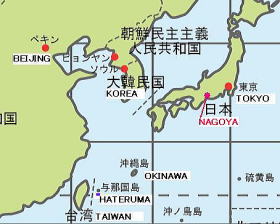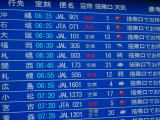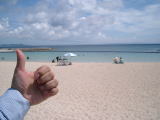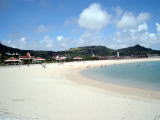I have read about the articles in CQ magazine written by JHIHUK Mr. Oshima who reported DX expedition by 430MHz from Kita Daito Island, Okinawa*1. At that time, I was not so curious about the DX by UHF frequency, however the story was so impressing for everybody if he was a radio operator.
When I first planned my CB operation in Okinawa, the memory kept in my mind made me try to plan the CB operation from Daito Islands, however, for me who is a poor corporate employee who cannot spend consecutive but only a day of paid leave, Daito Island was too hard to get to due to inconvenient flight access. Then I decided to plan an operation at Hateruma Island, thinking, if I were going to Okinawa, I should make it in the southernmost place in Japan, which was the Hateruma Island. On the other hand, I thought there would be a high risk that I would not be able to make any QSO, if I operate all three days in Hateruma, because QSO by 500mW QRP with use of rod antenna*2 had to rely on occurrence of Es (Sporadic E Region of Ionosphere) to be successful. I scheduled a plan to operate two days in Okinawa Island, plus one day in Hateruma and other useful time in Ishigaki Island. Because last year (2006) I made QSOs from Onnason in Okinawa Island with stations in 2, 3, and 0 Areas*3 in Honshu (main land of Japan), it seemed there should not be any risk at least from Okinawa Island to communicate with Honshu stations.
How should I travel to Okinawa? It was clear I would lose precious operation
time in Saturday if I flew from Centrair Airport*4 because the earliest
flight for Okinawa departs at 9:50. Then I thought I should try to get
on board the first flight from Haneda, Tokyo, which was 6:20. If I would
take the JAL flight, I must stay one night on Friday in Tokyo or take a
night train.
Friday night of June 22nd, I started out my home in Nagoya, making a feeble
joke to my family, hI would go to Okinawa by train, eMoonlight Nagaraf.h
Although the train departing Nagoya at 23:55, was marked as a simple regular,
eRapidf night train, the cars were as comfortable as those used for eLimited
Expressf train. Although it was a Friday night, next seat on the right
was vacant and time went by just relaxed and at ease.
Around 4 Ofclock in the morning, dawn was succeeding the night and the
train was passing over Sagami River. The sky with beautiful orange I have
never seen before struck me in the unclear consciousness just out of the
shallow sleep. Transfer at Shinagawa and Hamamatsucho stations allowed
me only 4 minutes each, which made me nervous as I carried a small-size
suit case, duffel bag, and fishing rod case.
The small Boeing 737 for Okinawa*5 departing from Haneda was completely occupied. For me it was always a sleeping time to sit in the airplane, whatever the travel is business or any other. After a while of sleeping, the airplane was arriving at Naha Airport without recognition. It would be such a loss of time to rent a car. After getting rice balls and a bottle of cold tea for lunch, I immediately moved to taxi area and started out. The destination was Azama Sun Sun Beach located in Nanjo City. After about a 45 minutes ride, it was around 20 minutes past 10 when I arrived at the beach. I already noticed in the taxi some CB station posted in the Web board of e11m Real Time QRV informatione, gchave been waiting for Okinawa station coming, but cannot yet hear. How about other watching stations?h It was more than 20 minutes of delay as I intended to be QRV from 10:00.
There spread a Prussian-blue sea and white sands symbolic of Okinawa in Azama Sun Sun Beach under the heavenly clear sky. People gathering in the beach were quite few: it was completely different from the similar scene in Honshu. It seemed a shame that only few people came for swimming in this beautiful waters. I was directly walking to a breakwater jettied from the beach, hauling a small suitcase. I felt a lifeguard giving a stupid look on me, but I was in completely another world. Restraining myself from hurrying, with a long sleeve shirt, trousers, sun glasses and a cap, which were totally mismatching with the beach anyway, I opened the luggage, took out an 87R and started watching.
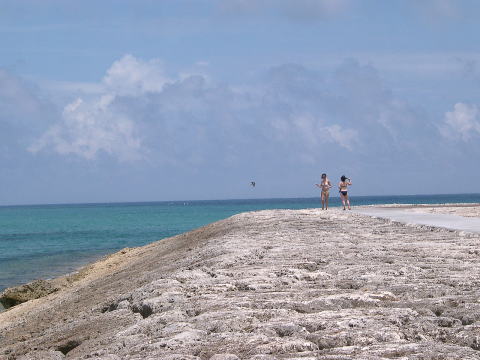
*1: Okinawa is one of the southern Islands in Japan, isolated from Japanese
main land called
hHonshuh. The distance between, for example, Tokyo in Honshu and Naha in
Okinawa, is about 1,560Km (975 miles)
*2: See "Japanese CB"
*3: In Amateur Radio, Japanese regions are divided into 10 areas, from 0 to 9. For example, the call sign of an amateur station in Nagoya is Jx2xxx. 2 Area includes stations in Aichi, Shizuoka, Gifu, Mie Prefectures. Visit the site of JARL for details. The amateur area codes were usually used for operating location in the Japanese CB, as many of the operators have amateur license.
*4: One of the airports, used by the people in Nagoya.
*5: Most of the plane used for this route are 747, 767 and 777 like other major domestic routes.
